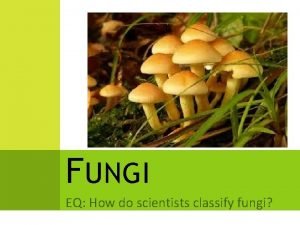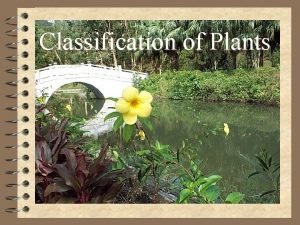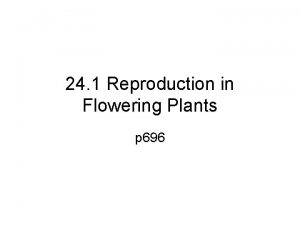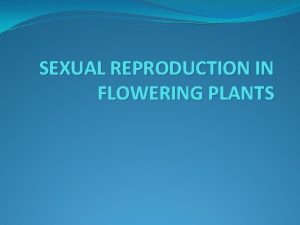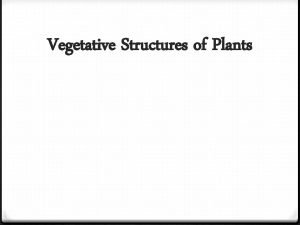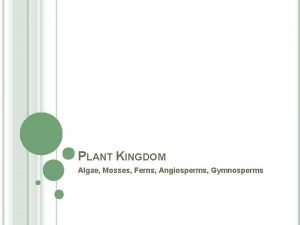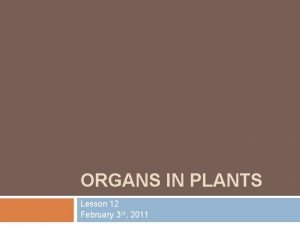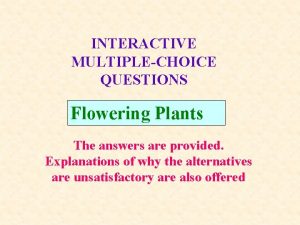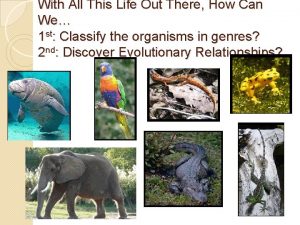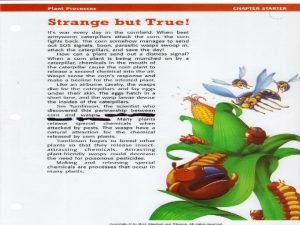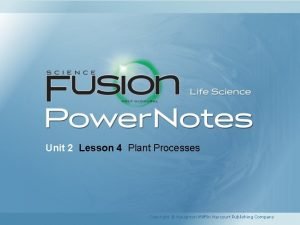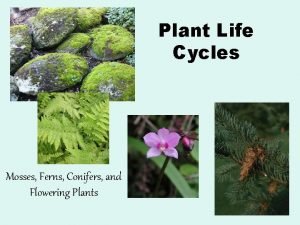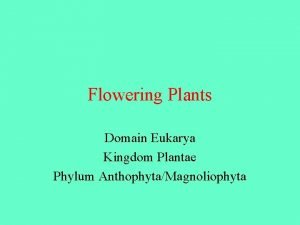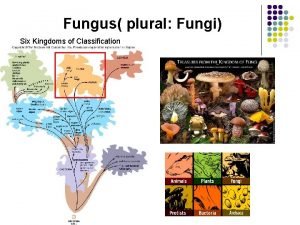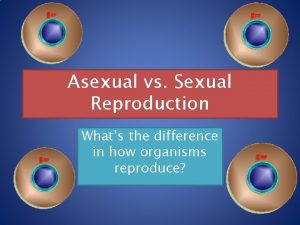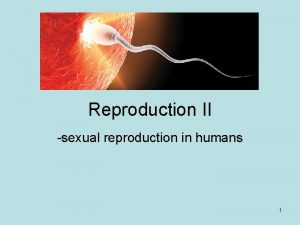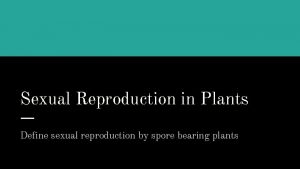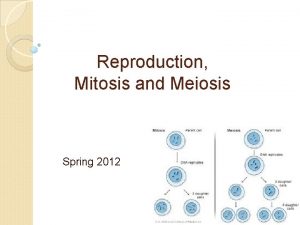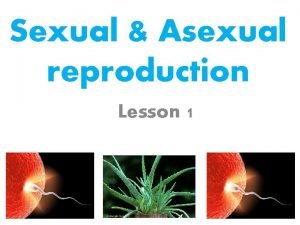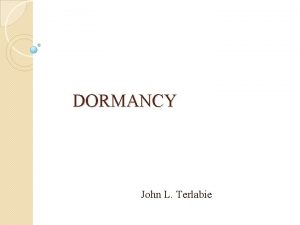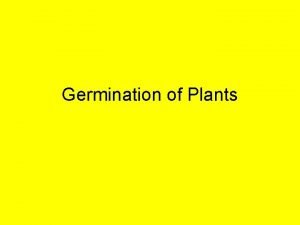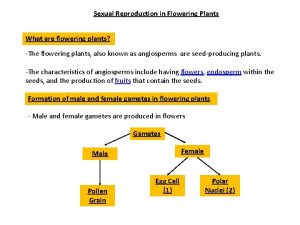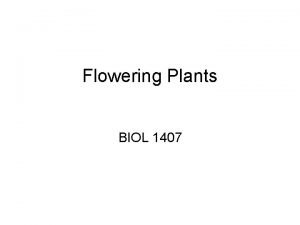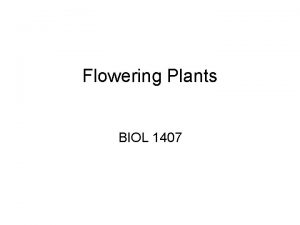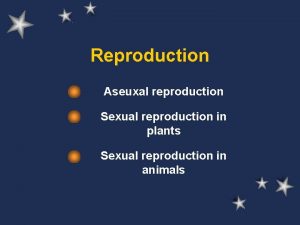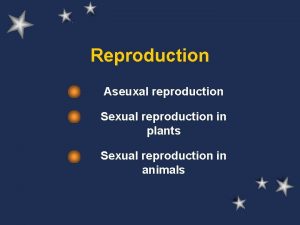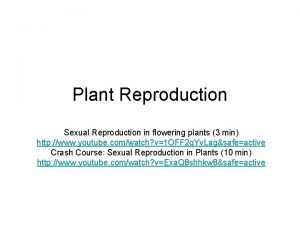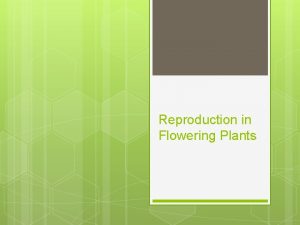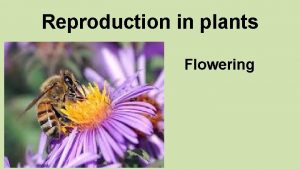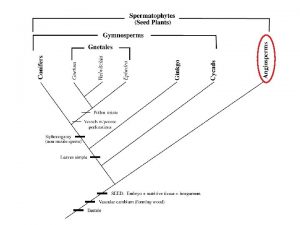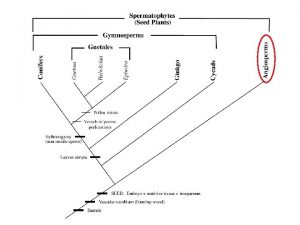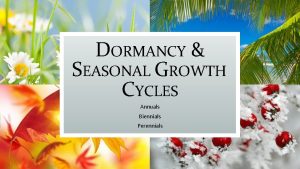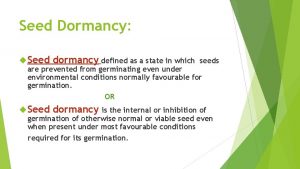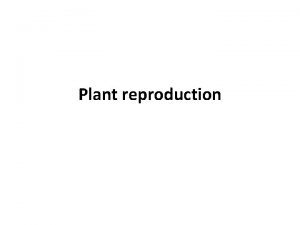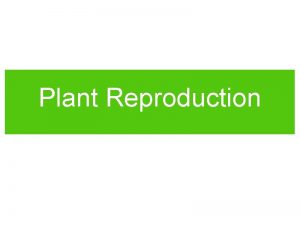Sexual Reproduction in Flowering Plants d Dormancy Germination
































- Slides: 32

Sexual Reproduction in Flowering Plants d) Dormancy & Germination

Learning objectives (3/4) • Define the term dormancy. • State advantages of dormancy. • Explain dormancy in agricultural & horticultural practice. • Define the term: Germination. • Explain the factors necessary for and role of digestion and respiration in germination. • Outline the stages of seed development 2

Dormancy and germination

Dormancy (definition) • A resting period when seeds undergo no growth and have reduced cell activity or metabolism. 4

Dormancy (advantages) • Plant avoids harsh winter conditions • Gives the embryo time to develop • Provides time for dispersal 5

Application in agriculture and horticulture • Some seeds need a period of cold before they germinate • It may be necessary to break dormancy in some seeds before they are planted for agricultural or horticultural purposes • This can be done by placing them in the fridge before they are planted 6

Germination • The re-growth of the embryo after a period of dormancy, if the environmental conditions are suitable 7

Germination – Factors necessary • Water • Oxygen • Suitable temperature or Warmth Mnemonic: WOW Dormancy must be complete 8

Germination – Factors necessary • Water – Activates the enzymes – Medium for germination reactions e. g. digestion – Transport medium for digested products 9

Germination – Factors necessary • Oxygen Needed for aerobic respiration • Suitable temperature Allows maximum enzyme activity 10

Events in Germination • Digestion – Of stored food in endosperm and cotyledon • Respiration – To produce ATP to drive cell division Events in germination cease when the plants leaves have developed and the plant has started to photosynthesise 11

Events in Germination (detail) • • Water is absorbed Food reserves are digested Digested food is moved to the embryo New cells are produced using amino acids Glucose is turned into ATP to drive cell division Radicle breaks through the testa Plumule emerges above ground New leaves begin to photosynthesise 12

Events in Germination Plumule Radicle Cotyledon 13

Events in Germination Plumule Radicle 14

Dry mass of seed (g) Changes in dry weight of seeds during germination Mass drops initially due to respiration of stored food, but then begins to increase due to photosynthesis Time (days) 15

Changes in dry weight of seeds during germination Dry mass of seed (g) Embryo Food reserves in endosperm are transferred to the growing embryo Endosperm Time (days) 16

Germination of broad bean (hypogeal) 17

Germination of broad bean (hypogeal) 18

Germination of broad bean Ground Seed – water is absorbed through the micropyle 19

Germination of broad bean The testa splits Radicle emerges 20

Germination of broad bean Plumule emerges Radicle continues to grow 21

Germination of broad bean The plumule is hooked to protect the leaves at the tip Epicotyl 22

Germination of broad bean The plumule grows above the surface of the soil Lateral roots develop 23

Germination of broad bean Plumule straightens and the leaves open out Throughout Hypogeal germination the cotyledons remain below the ground 24

Germination of sunflower (Epigael) Seed – water is absorbed through the micropyle 25

Germination of sunflower Radicle emerges 26

Germination of sunflower Hypocotyl Hook 27

Seed coat discarded Germination of sunflower Cotyledons Radicle grows downwards 28

Germination of sunflower Leaves emerge Cotyledons wither In Epigeal germination the cotyledons rise above the ground 29

Learning Check • Outline the main stages of sexual reproduction in plants 30

Review the plant life cycle After fertilization flower withers pollen is transferred 2 3 1 seeds disperse and germinate into new plant 4 seeds develop in ovary 31

Go to asexual reproduction in plants Thanks to PDST biology team 32
 Flowering plants and non flowering plants similarities
Flowering plants and non flowering plants similarities Classification of plants
Classification of plants Plants classification
Plants classification Reproduction in flowering plants
Reproduction in flowering plants Hare lynx
Hare lynx Venn diagram asexual vs sexual reproduction
Venn diagram asexual vs sexual reproduction Venn diagram of sexual and asexual reproduction
Venn diagram of sexual and asexual reproduction A sexual reproduction in plants
A sexual reproduction in plants [email protected]
[email protected] Scell dormancy
Scell dormancy Define seed dormancy
Define seed dormancy Tube nucleus
Tube nucleus Primary root and secondary root
Primary root and secondary root Moss fern gymnosperm angiosperm
Moss fern gymnosperm angiosperm Plant organ
Plant organ Multiple choice questions on flowering plants
Multiple choice questions on flowering plants Phylogenic
Phylogenic Produces pollen grains
Produces pollen grains øa section through a leaf
øa section through a leaf What is called flowering plants
What is called flowering plants Unit 2 lesson 10 seedless plants
Unit 2 lesson 10 seedless plants Classification of mosses ferns and conifers
Classification of mosses ferns and conifers Plantae phylum
Plantae phylum Flower plant parts name
Flower plant parts name Venn diagram sexual and asexual
Venn diagram sexual and asexual Plural for fungi
Plural for fungi Whats asexual reproduction
Whats asexual reproduction A sexual reproduction in humans
A sexual reproduction in humans Define sexual reproduction
Define sexual reproduction Mitosis definition
Mitosis definition Difference between sexual and asexual reproduction
Difference between sexual and asexual reproduction Reproduction
Reproduction Significance of sexual reproduction
Significance of sexual reproduction

